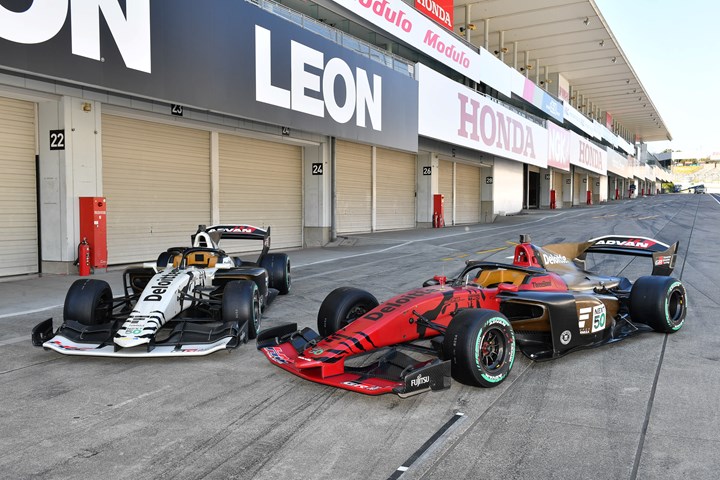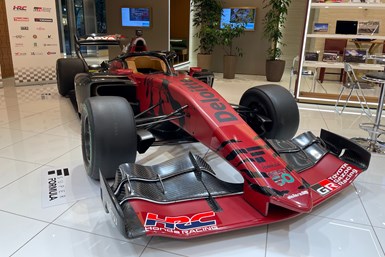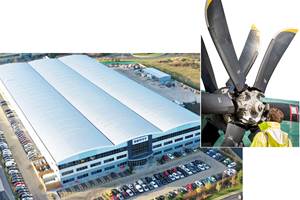Super Formula, Bcomp announce sustainable fiber composite bodywork
Japan’s premiere single-seater race series confirms hybrid composite parts for SF23 chassis as part of Next 50 plan.
First test for Super Formula and Bcomp SF23 race car. Photo Credit, all images: Super Formula, Bcomp
Swiss lightweighting specialists Bcomp Ltd. (Fribourg) and Super Formula, a Japanese open-wheeled racing championship, have confirmed a collaborative partnership for the new era of Japan’s premiere single-seater race series. Following successful testing of Bcomp’s flax fiber composites, Super Formula has confirmed the bodywork parts will appear on the new SF23 chassis.
The announcement was made on the championship’s 50th anniversary, with Super Formula looking ahead to its future and undertaking significant steps to target carbon neutrality, going as far as having specified measures for the use of new tire compounds with recycled rubber and natural compounding agents, in addition to the use of more sustainable
materials in the race cars’ construction.
Carbon fiber bodywork is used extensively throughout the motorsport industry and is responsible for a substantial carbon footprint. Many of the carbon fiber parts used in racing end up in landfills when damaged in a race, or when no longer needed. Bcomp’s ampliTex and powerRibs composite technologies, made from flax fiber, have shown to be a promising alternative, extensively proving their performance across the board in motorsports series from F1 to Formula E, Extreme E, DTM and GT4 on Porsche, Mercedes
Benz-AMG and BMW M GT cars (see below for examples).
Flax fibers achieve low density, high mechanical properties. The combination of ampliTex flax fabrics with patented powerRibs reinforcement grid enables the solution to match the low weight and high stiffness of carbon fiber bodywork parts in a more sustainable way — including a reduction of 90% in material CO2 emissions, and more than 80% reduction of CO2 emissions from cradle-to-gate, considering all production steps from raw material to the final part. The natural fiber composite also introduces safer crash behavior and eliminates the need to landfill damaged or old bodyworks.
Extensive testing has been conducted in 2022 by Super Formula drivers to evaluate the new engines, fuels, tires and, of course, the Bcomp bodywork. Sidepods and engine covers, entirely made from ampliTex and powerRibs, performed well in the initial tests Super Formula notes, but it seemed more appropriate to create hybrid parts for the implementation in the SF23. A
construction with about 70% flax and only 30% carbon fiber for local reinforcements proved to be an ideal combination of each material’s benefits, while still significantly reducing the carbon footprint. The collaboration has been nominated as a finalist for this year’s World Motorsport Symposium Green Tech Award.
“Super Formula is considered the second fastest racing series in the world and proves that sustainable technologies are ready to compete at the very highest performance level,” Johann Wacht, manager motorsports and supercars at Bcomp. “The series shows to the industry what is possible, and we are looking forward to a great season full of entertainment and sustainable innovations!”
The 2023 Super Formula will feature nine races across seven events, with double headers at the season opener at Fuji and the season finale at Suzuka next October.
Related Content
Carbon fiber in pressure vessels for hydrogen
The emerging H2 economy drives tank development for aircraft, ships and gas transport.
Read MoreMaterials & Processes: Resin matrices for composites
The matrix binds the fiber reinforcement, gives the composite component its shape and determines its surface quality. A composite matrix may be a polymer, ceramic, metal or carbon. Here’s a guide to selection.
Read MoreBio-based acrylonitrile for carbon fiber manufacture
The quest for a sustainable source of acrylonitrile for carbon fiber manufacture has made the leap from the lab to the market.
Read MorePlant tour: Dowty Propellers, Gloucester, U.K.
Transforming decades of design and RTM production reliability into more sustainable, next-generation composite propellers.
Read MoreRead Next
CW’s 2024 Top Shops survey offers new approach to benchmarking
Respondents that complete the survey by April 30, 2024, have the chance to be recognized as an honoree.
Read MoreComposites end markets: Energy (2024)
Composites are used widely in oil/gas, wind and other renewable energy applications. Despite market challenges, growth potential and innovation for composites continue.
Read MoreFrom the CW Archives: The tale of the thermoplastic cryotank
In 2006, guest columnist Bob Hartunian related the story of his efforts two decades prior, while at McDonnell Douglas, to develop a thermoplastic composite crytank for hydrogen storage. He learned a lot of lessons.
Read More


















.jpg;maxWidth=300;quality=90)








